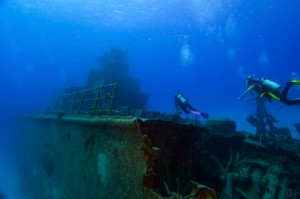Nazis, Sunken Ships, and a 67 Year-Old Game of Telephone
This is a guest post by Jeff Mosenkis, a freelance producer with Freakonomics Radio who holds a Ph.D. in psychology and comparative human development.
Nazis, Sunken Ships, And a 60 Year-Old Game of Telephone
By Jeff Mosenkis
Did you hear the one about the two statisticians who go deer hunting? The first one misses his shot ten feet to the right of the deer; the second one misses ten feet to the left of the deer. They then high five each other and shout “Got him!”
While the quantitative method might not work for hunting, it apparently does for finding sunken warships. NPR’s Alix Spiegel reported this remarkable story about two Australian cognitive psychologists who used a statistical distribution to find two sunken World War II ships, 67 years after they were lost.
 On the evening of November 19, 1941, the HMAS Sydney was off the coast of Western Australia when it exchanged fire with the German HSK Kormoran, and sunk with all 645 crewmen aboard. It was a national tragedy, particularly because nobody knew exactly what happened to the ship and why it sunk. The German crew scuttled their damaged ship, and 317 surviving German sailors were picked up in lifeboats at sea or on shore and interrogated. Seventy offered a last location of the ships (including the captain) but the locations varied by as much as 100 miles, so most assumed they were lying, and none of the expeditions over the years were able to find the sunken ships.
On the evening of November 19, 1941, the HMAS Sydney was off the coast of Western Australia when it exchanged fire with the German HSK Kormoran, and sunk with all 645 crewmen aboard. It was a national tragedy, particularly because nobody knew exactly what happened to the ship and why it sunk. The German crew scuttled their damaged ship, and 317 surviving German sailors were picked up in lifeboats at sea or on shore and interrogated. Seventy offered a last location of the ships (including the captain) but the locations varied by as much as 100 miles, so most assumed they were lying, and none of the expeditions over the years were able to find the sunken ships.
But recently, psychologists John Dunn and Kim Kirsner took another look (paper here) and mapped out a statistical distribution of the locations given. They discovered that it conformed to a hyperbolic, or “lazy J-curve” distribution often found in natural phenomena. The distribution of species within an ecosystem takes this shape, so do genome sequences, and crucially, information reconstructed from memory.
Memory, both inside us and when shared between people, works a lot like that old “telephone” game. Every time a story is retold (even one person retelling the same story) the content shifts a little bit. When Dunn and Kirsner mapped out all the pieces of information, they found that it mirrored classic studies of story retelling. Knowing this, they statistically modeled the pattern and error, factored in other information (like location of drifting debris) and proposed a search area. A new expedition found the Sydney about 3 miles from the location that Dunn & Kirsner had estimated.
So the statistical method might not work on deer, but who knows, maybe the History Channel will start airing “Quantitative Treasure Hunters” soon.

Comments